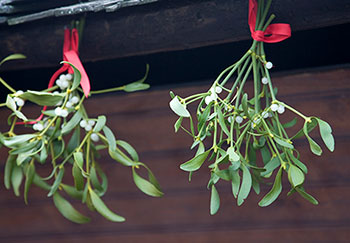
Deck the halls with boughs of holly — just don’t eat them!
Many of the plants we associate with the holiday season have a reputation for being poisonous. But which ones are dangerous? How serious is the threat? Should you forgo potentially poisonous holiday plants if you have young children?
Experts from the Blue Ridge Poison Center help separate fact from fiction and offer some safety tips for your family.
Be Cautious With These Holiday Plants
Mistletoe
American Mistletoe (Phoradendron loranthaceae) has smooth, green oval shaped leaves and clusters of waxy white berries. Mistletoe is a parasitic plant. It grows as a clump clinging to the branches and trunks of deciduous trees throughout the U.S. The entire plant contains toxins that can cause gastrointestinal problems such as nausea, vomiting, and diarrhea if swallowed.
Most cases reported to poison centers in the past 25 years involved young children who ate only a few leaves or berries at most. In those cases, symptoms were either mild or did not develop at all.
Severe reactions are less common and associated with eating larger amounts of the plant, especially the leaves. If young children are going to be present in your home this holiday season, keep mistletoe up high, out of their reach. Stay vigilant for any leaves or berries that drop to the ground. Note — your pet might be attracted to those, too.
Holly
Holly (Ilex species) is a small evergreen tree or shrub with stiff, prickly leaves and red berries. The berries contain toxic compounds. These can cause nausea, vomiting, diarrhea, and —in rare cases — drowsiness.
Swallowing 20-30 berries is a toxic dose for adults, although there are reports of people who experienced symptoms after swallowing smaller amounts. Symptoms have been reported in children who swallowed as few as five berries. Young children may be particularly attracted to the bright red berries. The leaves are not poisonous, but could be a choking hazard.
Bulbs
There are many species of spring-blooming, fragrant plants which grow from a bulb. Several, including amaryllis, paperwhites, daffodils, and hyacinth, have become popular holiday favorites.
We bring dormant bulbs indoors in autumn to encourage full bloom a few months early. These plants may be poisonous, especially the bulbs that look like onions or shallots. Avoid mistaken identity — store loose bulbs in a safe place, far from food, where children can’t reach.
If you eat them, you may have symptoms such as nausea, vomiting, and diarrhea. Some bulb species also contain compounds that can cause burning and irritation of the mouth, throat, and skin.
Not Poisonous — but Beware of Choking Hazard
Poinsettia
Poinsettia (Euphorbia pulcherrima) is a showy shrub with green leaves and “flowers” that are red, white, or pink. The flowers are not true flowers; they’re leaves that changed color. Poinsettias have a reputation for being deadly, but in fact, they’re not poisonous at all.
The plant does contain a sap that can cause minor skin irritation in some people. This sap can be irritating to the mouth and stomach if swallowed. Also, the large, soft leaves could be a choking hazard for a young child.
Evergreen Trees
Trees we use for Christmas trees and decorations, including pine, spruce and fir, aren’t poisonous. However, their stiff needles make them a choking hazard.
Had contact with a poisonous holiday plant?
If you’re concerned about someone who has had any contact with a plant, call the Blue Ridge Poison Center right away for help: 1.800.222.1222. Don’t wait for someone to look or feel sick.
Christmas Cactus
These potted plants aren’t poisonous. But like many of the other plants mentioned here, their spiky leaves are a choking hazard for children.
Poisonous Holiday Plants: Things to Keep in Mind
- Some plants may be dangerous only under specific conditions. For example, steeping a plant in hot water to make an herbal “tea” could concentrate harmful compounds into a poisonous amount. (In fact, there are two recorded deaths which resulted from a homemade mistletoe tea.)
- Sometimes only certain parts of a plant are poisonous. For example, it is unsafe to eat the green parts of the potato plant, or the seeds of the castor bean (aka tickseed) plant.
- It could be harmful to swallow any plant if it has been sprayed with certain pesticides, fertilizers or decorative products such as paint or glitter.
- Know what is growing in your house and yard. Bring clippings to a nursery if you need help identifying plants. Teach children not to eat plants, berries and mushrooms they find growing outdoors.
Get a list of toxic indoor and outdoor plants (PDF).
This article about poisonous holiday plants has been repurposed from The Antidote, a newsletter of the Blue Ridge Poison Center.
